Auditing and Assurance Report: Retail Food Group Performance Review
VerifiedAdded on 2021/06/17
|17
|4545
|62
Report
AI Summary
This report provides a comprehensive analysis of the auditing and assurance practices of the Retail Food Group (RFG), examining its financial performance and internal controls. The analysis includes an evaluation of the 2016 and 2017 audit reports, assessing the type and appropriateness of the auditor's report. The report delves into RFG's internal control environment, identifying weaknesses and proposing solutions to mitigate risks. It also explores the business risks associated with RFG from an auditor's perspective, considering ethical issues and operational deficiencies. The report emphasizes the importance of ethical considerations for auditors and concludes with a summary of key findings and recommendations.

Auditing and Assurance of the Retail Food Group 1
AUDITING AND ASSURANCE OF THE RETAIL FOOD GROUP
Student by (Name)
Professor’s (Name)
College
Course
Date
AUDITING AND ASSURANCE OF THE RETAIL FOOD GROUP
Student by (Name)
Professor’s (Name)
College
Course
Date
Paraphrase This Document
Need a fresh take? Get an instant paraphrase of this document with our AI Paraphraser
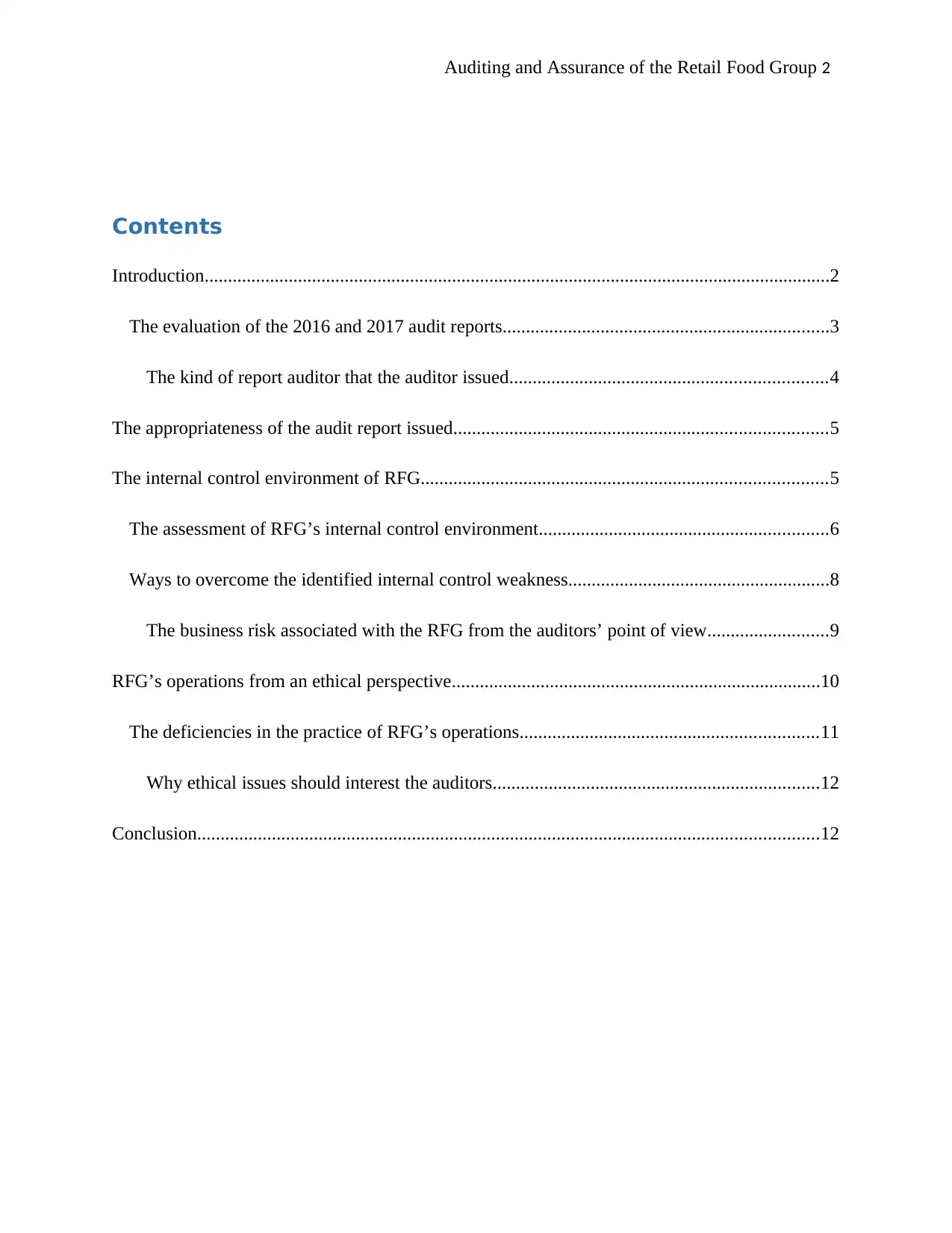
Auditing and Assurance of the Retail Food Group 2
Contents
Introduction......................................................................................................................................2
The evaluation of the 2016 and 2017 audit reports......................................................................3
The kind of report auditor that the auditor issued....................................................................4
The appropriateness of the audit report issued................................................................................5
The internal control environment of RFG.......................................................................................5
The assessment of RFG’s internal control environment..............................................................6
Ways to overcome the identified internal control weakness........................................................8
The business risk associated with the RFG from the auditors’ point of view..........................9
RFG’s operations from an ethical perspective...............................................................................10
The deficiencies in the practice of RFG’s operations................................................................11
Why ethical issues should interest the auditors......................................................................12
Conclusion.....................................................................................................................................12
Contents
Introduction......................................................................................................................................2
The evaluation of the 2016 and 2017 audit reports......................................................................3
The kind of report auditor that the auditor issued....................................................................4
The appropriateness of the audit report issued................................................................................5
The internal control environment of RFG.......................................................................................5
The assessment of RFG’s internal control environment..............................................................6
Ways to overcome the identified internal control weakness........................................................8
The business risk associated with the RFG from the auditors’ point of view..........................9
RFG’s operations from an ethical perspective...............................................................................10
The deficiencies in the practice of RFG’s operations................................................................11
Why ethical issues should interest the auditors......................................................................12
Conclusion.....................................................................................................................................12
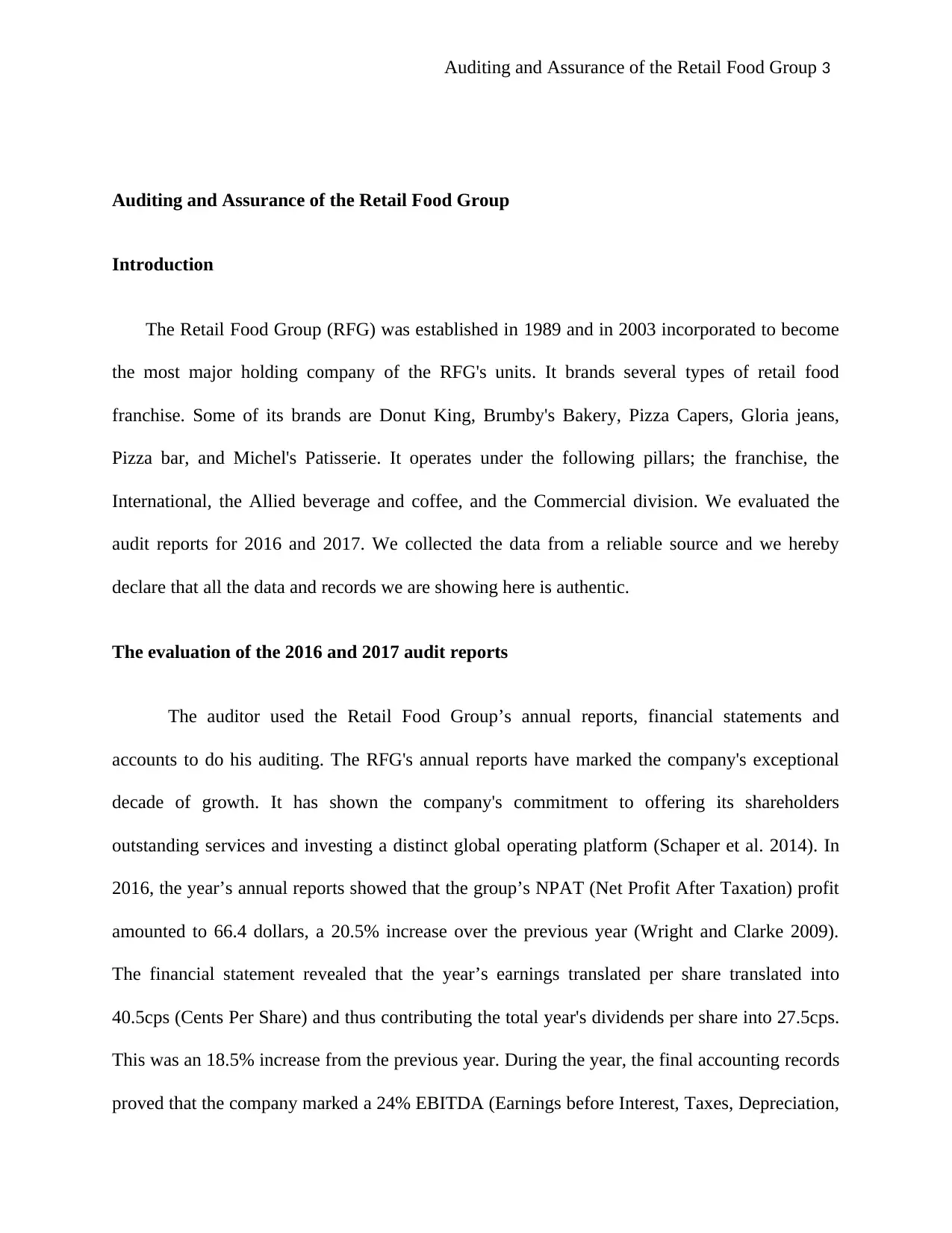
Auditing and Assurance of the Retail Food Group 3
Auditing and Assurance of the Retail Food Group
Introduction
The Retail Food Group (RFG) was established in 1989 and in 2003 incorporated to become
the most major holding company of the RFG's units. It brands several types of retail food
franchise. Some of its brands are Donut King, Brumby's Bakery, Pizza Capers, Gloria jeans,
Pizza bar, and Michel's Patisserie. It operates under the following pillars; the franchise, the
International, the Allied beverage and coffee, and the Commercial division. We evaluated the
audit reports for 2016 and 2017. We collected the data from a reliable source and we hereby
declare that all the data and records we are showing here is authentic.
The evaluation of the 2016 and 2017 audit reports
The auditor used the Retail Food Group’s annual reports, financial statements and
accounts to do his auditing. The RFG's annual reports have marked the company's exceptional
decade of growth. It has shown the company's commitment to offering its shareholders
outstanding services and investing a distinct global operating platform (Schaper et al. 2014). In
2016, the year’s annual reports showed that the group’s NPAT (Net Profit After Taxation) profit
amounted to 66.4 dollars, a 20.5% increase over the previous year (Wright and Clarke 2009).
The financial statement revealed that the year’s earnings translated per share translated into
40.5cps (Cents Per Share) and thus contributing the total year's dividends per share into 27.5cps.
This was an 18.5% increase from the previous year. During the year, the final accounting records
proved that the company marked a 24% EBITDA (Earnings before Interest, Taxes, Depreciation,
Auditing and Assurance of the Retail Food Group
Introduction
The Retail Food Group (RFG) was established in 1989 and in 2003 incorporated to become
the most major holding company of the RFG's units. It brands several types of retail food
franchise. Some of its brands are Donut King, Brumby's Bakery, Pizza Capers, Gloria jeans,
Pizza bar, and Michel's Patisserie. It operates under the following pillars; the franchise, the
International, the Allied beverage and coffee, and the Commercial division. We evaluated the
audit reports for 2016 and 2017. We collected the data from a reliable source and we hereby
declare that all the data and records we are showing here is authentic.
The evaluation of the 2016 and 2017 audit reports
The auditor used the Retail Food Group’s annual reports, financial statements and
accounts to do his auditing. The RFG's annual reports have marked the company's exceptional
decade of growth. It has shown the company's commitment to offering its shareholders
outstanding services and investing a distinct global operating platform (Schaper et al. 2014). In
2016, the year’s annual reports showed that the group’s NPAT (Net Profit After Taxation) profit
amounted to 66.4 dollars, a 20.5% increase over the previous year (Wright and Clarke 2009).
The financial statement revealed that the year’s earnings translated per share translated into
40.5cps (Cents Per Share) and thus contributing the total year's dividends per share into 27.5cps.
This was an 18.5% increase from the previous year. During the year, the final accounting records
proved that the company marked a 24% EBITDA (Earnings before Interest, Taxes, Depreciation,
⊘ This is a preview!⊘
Do you want full access?
Subscribe today to unlock all pages.

Trusted by 1+ million students worldwide
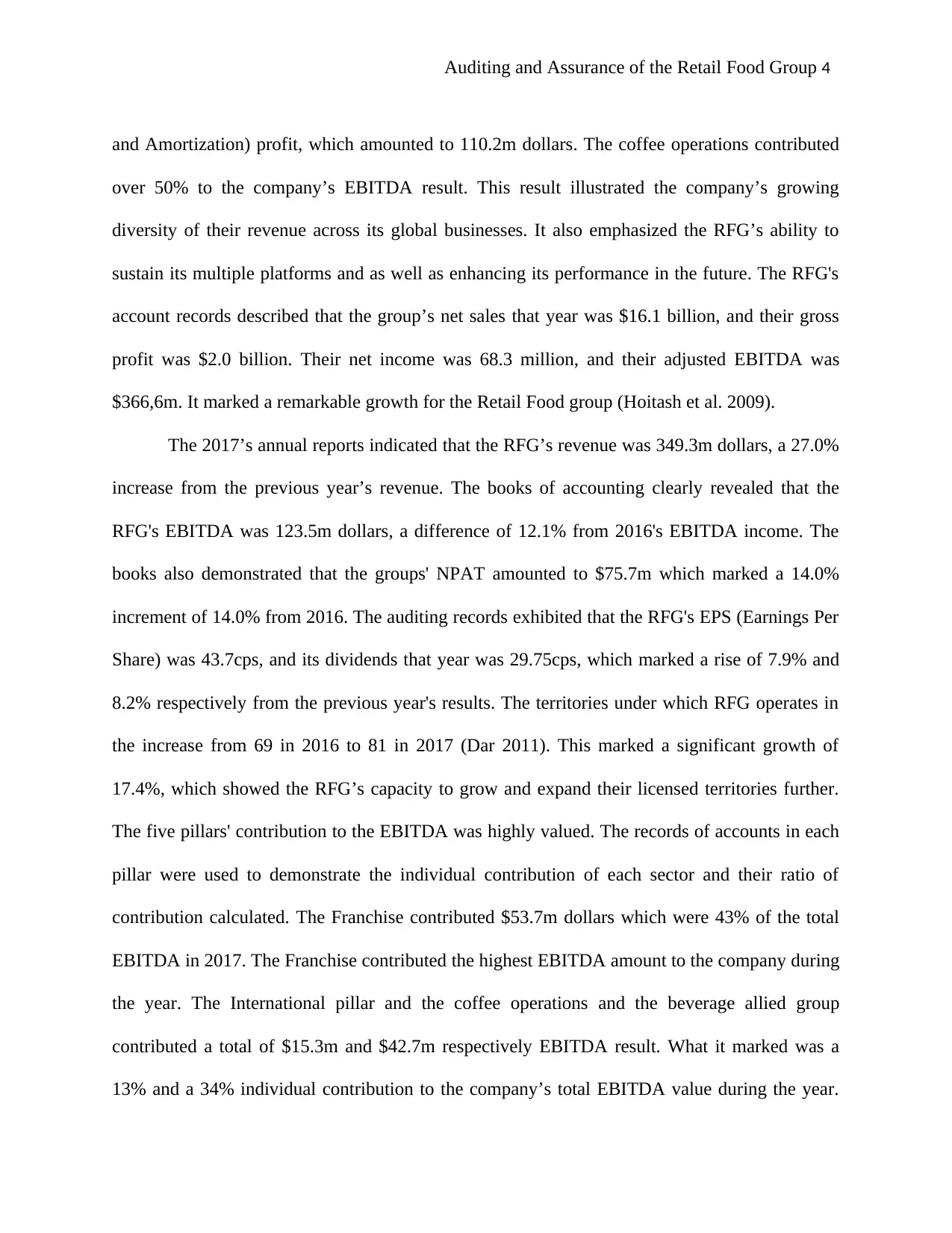
Auditing and Assurance of the Retail Food Group 4
and Amortization) profit, which amounted to 110.2m dollars. The coffee operations contributed
over 50% to the company’s EBITDA result. This result illustrated the company’s growing
diversity of their revenue across its global businesses. It also emphasized the RFG’s ability to
sustain its multiple platforms and as well as enhancing its performance in the future. The RFG's
account records described that the group’s net sales that year was $16.1 billion, and their gross
profit was $2.0 billion. Their net income was 68.3 million, and their adjusted EBITDA was
$366,6m. It marked a remarkable growth for the Retail Food group (Hoitash et al. 2009).
The 2017’s annual reports indicated that the RFG’s revenue was 349.3m dollars, a 27.0%
increase from the previous year’s revenue. The books of accounting clearly revealed that the
RFG's EBITDA was 123.5m dollars, a difference of 12.1% from 2016's EBITDA income. The
books also demonstrated that the groups' NPAT amounted to $75.7m which marked a 14.0%
increment of 14.0% from 2016. The auditing records exhibited that the RFG's EPS (Earnings Per
Share) was 43.7cps, and its dividends that year was 29.75cps, which marked a rise of 7.9% and
8.2% respectively from the previous year's results. The territories under which RFG operates in
the increase from 69 in 2016 to 81 in 2017 (Dar 2011). This marked a significant growth of
17.4%, which showed the RFG’s capacity to grow and expand their licensed territories further.
The five pillars' contribution to the EBITDA was highly valued. The records of accounts in each
pillar were used to demonstrate the individual contribution of each sector and their ratio of
contribution calculated. The Franchise contributed $53.7m dollars which were 43% of the total
EBITDA in 2017. The Franchise contributed the highest EBITDA amount to the company during
the year. The International pillar and the coffee operations and the beverage allied group
contributed a total of $15.3m and $42.7m respectively EBITDA result. What it marked was a
13% and a 34% individual contribution to the company’s total EBITDA value during the year.
and Amortization) profit, which amounted to 110.2m dollars. The coffee operations contributed
over 50% to the company’s EBITDA result. This result illustrated the company’s growing
diversity of their revenue across its global businesses. It also emphasized the RFG’s ability to
sustain its multiple platforms and as well as enhancing its performance in the future. The RFG's
account records described that the group’s net sales that year was $16.1 billion, and their gross
profit was $2.0 billion. Their net income was 68.3 million, and their adjusted EBITDA was
$366,6m. It marked a remarkable growth for the Retail Food group (Hoitash et al. 2009).
The 2017’s annual reports indicated that the RFG’s revenue was 349.3m dollars, a 27.0%
increase from the previous year’s revenue. The books of accounting clearly revealed that the
RFG's EBITDA was 123.5m dollars, a difference of 12.1% from 2016's EBITDA income. The
books also demonstrated that the groups' NPAT amounted to $75.7m which marked a 14.0%
increment of 14.0% from 2016. The auditing records exhibited that the RFG's EPS (Earnings Per
Share) was 43.7cps, and its dividends that year was 29.75cps, which marked a rise of 7.9% and
8.2% respectively from the previous year's results. The territories under which RFG operates in
the increase from 69 in 2016 to 81 in 2017 (Dar 2011). This marked a significant growth of
17.4%, which showed the RFG’s capacity to grow and expand their licensed territories further.
The five pillars' contribution to the EBITDA was highly valued. The records of accounts in each
pillar were used to demonstrate the individual contribution of each sector and their ratio of
contribution calculated. The Franchise contributed $53.7m dollars which were 43% of the total
EBITDA in 2017. The Franchise contributed the highest EBITDA amount to the company during
the year. The International pillar and the coffee operations and the beverage allied group
contributed a total of $15.3m and $42.7m respectively EBITDA result. What it marked was a
13% and a 34% individual contribution to the company’s total EBITDA value during the year.
Paraphrase This Document
Need a fresh take? Get an instant paraphrase of this document with our AI Paraphraser
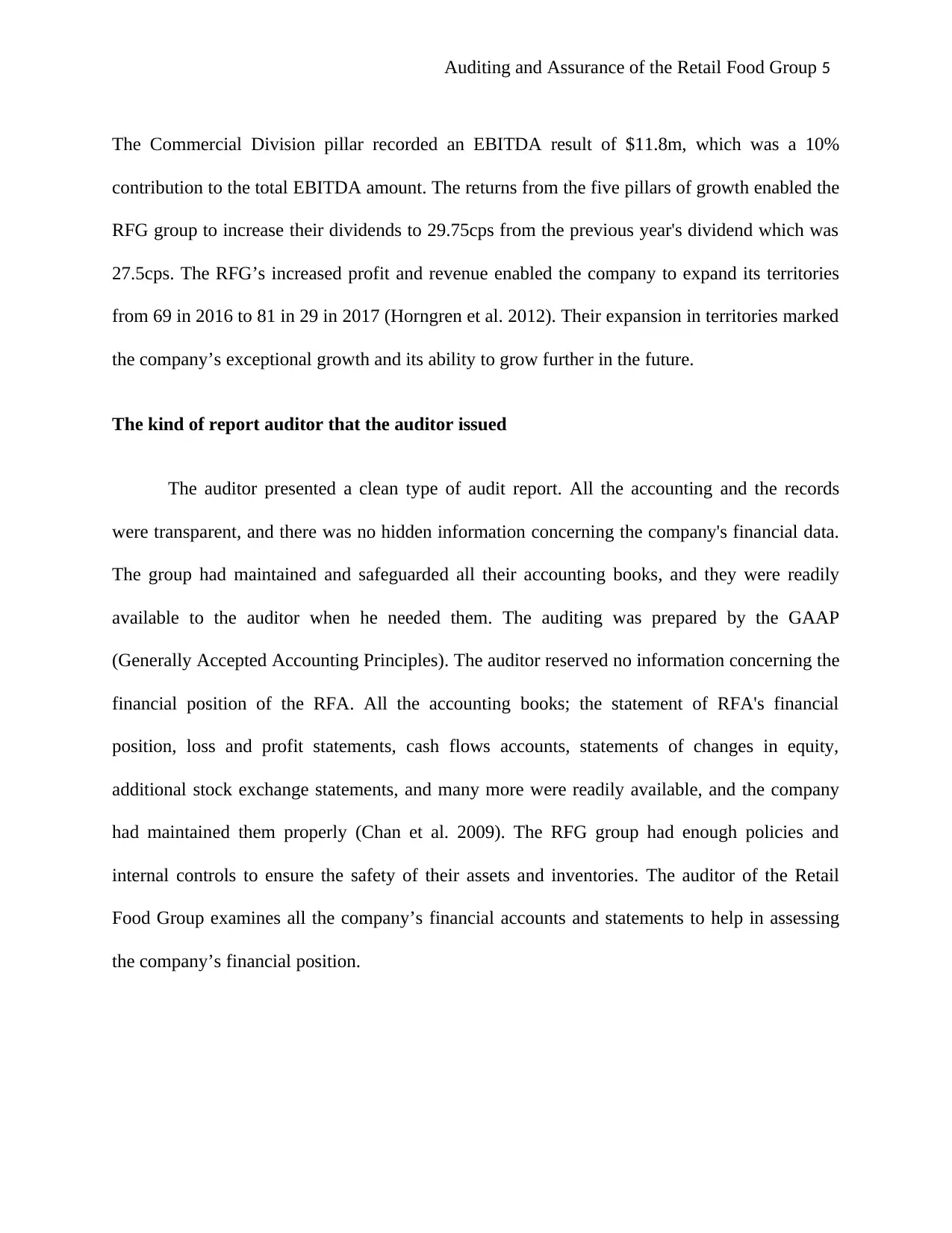
Auditing and Assurance of the Retail Food Group 5
The Commercial Division pillar recorded an EBITDA result of $11.8m, which was a 10%
contribution to the total EBITDA amount. The returns from the five pillars of growth enabled the
RFG group to increase their dividends to 29.75cps from the previous year's dividend which was
27.5cps. The RFG’s increased profit and revenue enabled the company to expand its territories
from 69 in 2016 to 81 in 29 in 2017 (Horngren et al. 2012). Their expansion in territories marked
the company’s exceptional growth and its ability to grow further in the future.
The kind of report auditor that the auditor issued
The auditor presented a clean type of audit report. All the accounting and the records
were transparent, and there was no hidden information concerning the company's financial data.
The group had maintained and safeguarded all their accounting books, and they were readily
available to the auditor when he needed them. The auditing was prepared by the GAAP
(Generally Accepted Accounting Principles). The auditor reserved no information concerning the
financial position of the RFA. All the accounting books; the statement of RFA's financial
position, loss and profit statements, cash flows accounts, statements of changes in equity,
additional stock exchange statements, and many more were readily available, and the company
had maintained them properly (Chan et al. 2009). The RFG group had enough policies and
internal controls to ensure the safety of their assets and inventories. The auditor of the Retail
Food Group examines all the company’s financial accounts and statements to help in assessing
the company’s financial position.
The Commercial Division pillar recorded an EBITDA result of $11.8m, which was a 10%
contribution to the total EBITDA amount. The returns from the five pillars of growth enabled the
RFG group to increase their dividends to 29.75cps from the previous year's dividend which was
27.5cps. The RFG’s increased profit and revenue enabled the company to expand its territories
from 69 in 2016 to 81 in 29 in 2017 (Horngren et al. 2012). Their expansion in territories marked
the company’s exceptional growth and its ability to grow further in the future.
The kind of report auditor that the auditor issued
The auditor presented a clean type of audit report. All the accounting and the records
were transparent, and there was no hidden information concerning the company's financial data.
The group had maintained and safeguarded all their accounting books, and they were readily
available to the auditor when he needed them. The auditing was prepared by the GAAP
(Generally Accepted Accounting Principles). The auditor reserved no information concerning the
financial position of the RFA. All the accounting books; the statement of RFA's financial
position, loss and profit statements, cash flows accounts, statements of changes in equity,
additional stock exchange statements, and many more were readily available, and the company
had maintained them properly (Chan et al. 2009). The RFG group had enough policies and
internal controls to ensure the safety of their assets and inventories. The auditor of the Retail
Food Group examines all the company’s financial accounts and statements to help in assessing
the company’s financial position.
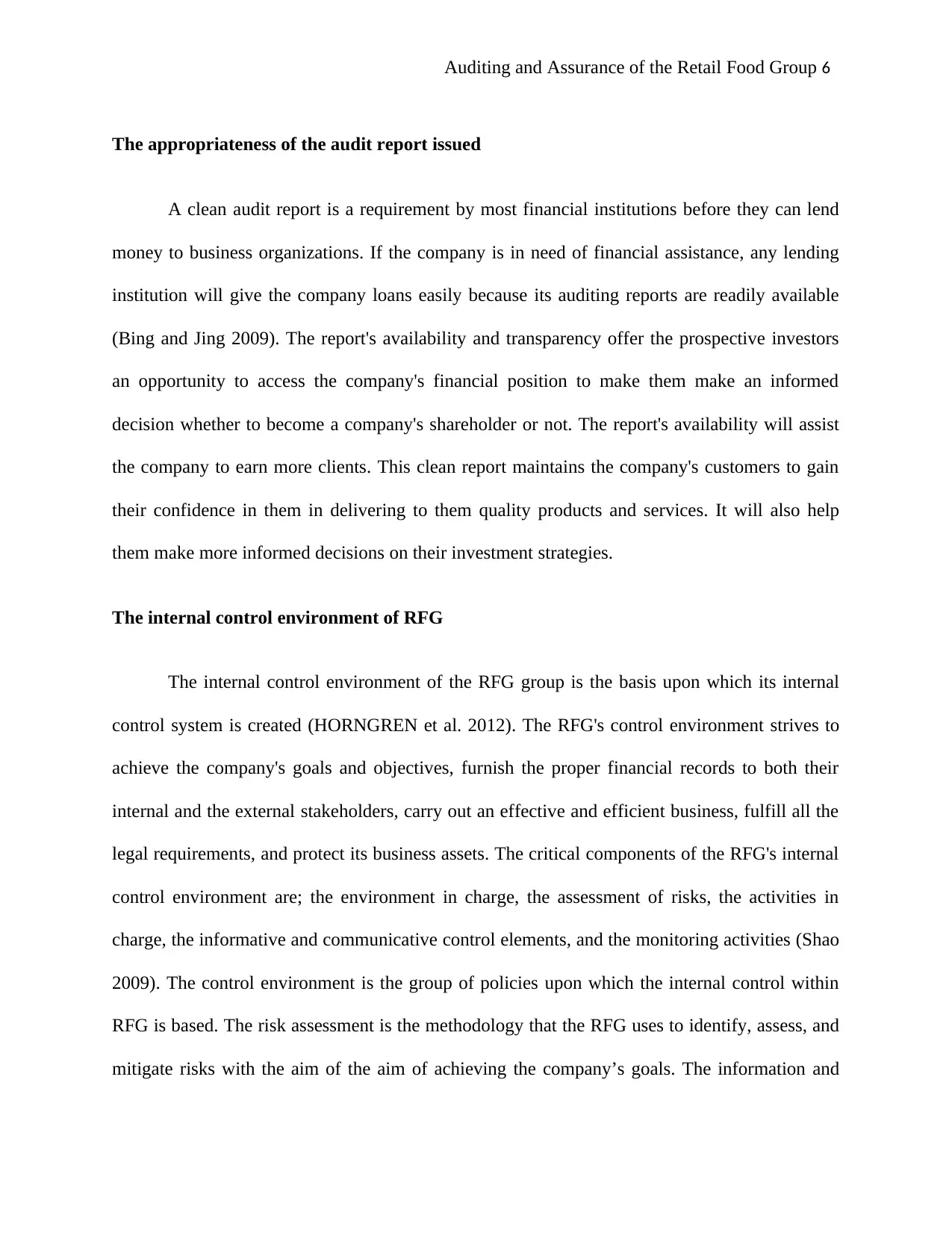
Auditing and Assurance of the Retail Food Group 6
The appropriateness of the audit report issued
A clean audit report is a requirement by most financial institutions before they can lend
money to business organizations. If the company is in need of financial assistance, any lending
institution will give the company loans easily because its auditing reports are readily available
(Bing and Jing 2009). The report's availability and transparency offer the prospective investors
an opportunity to access the company's financial position to make them make an informed
decision whether to become a company's shareholder or not. The report's availability will assist
the company to earn more clients. This clean report maintains the company's customers to gain
their confidence in them in delivering to them quality products and services. It will also help
them make more informed decisions on their investment strategies.
The internal control environment of RFG
The internal control environment of the RFG group is the basis upon which its internal
control system is created (HORNGREN et al. 2012). The RFG's control environment strives to
achieve the company's goals and objectives, furnish the proper financial records to both their
internal and the external stakeholders, carry out an effective and efficient business, fulfill all the
legal requirements, and protect its business assets. The critical components of the RFG's internal
control environment are; the environment in charge, the assessment of risks, the activities in
charge, the informative and communicative control elements, and the monitoring activities (Shao
2009). The control environment is the group of policies upon which the internal control within
RFG is based. The risk assessment is the methodology that the RFG uses to identify, assess, and
mitigate risks with the aim of the aim of achieving the company’s goals. The information and
The appropriateness of the audit report issued
A clean audit report is a requirement by most financial institutions before they can lend
money to business organizations. If the company is in need of financial assistance, any lending
institution will give the company loans easily because its auditing reports are readily available
(Bing and Jing 2009). The report's availability and transparency offer the prospective investors
an opportunity to access the company's financial position to make them make an informed
decision whether to become a company's shareholder or not. The report's availability will assist
the company to earn more clients. This clean report maintains the company's customers to gain
their confidence in them in delivering to them quality products and services. It will also help
them make more informed decisions on their investment strategies.
The internal control environment of RFG
The internal control environment of the RFG group is the basis upon which its internal
control system is created (HORNGREN et al. 2012). The RFG's control environment strives to
achieve the company's goals and objectives, furnish the proper financial records to both their
internal and the external stakeholders, carry out an effective and efficient business, fulfill all the
legal requirements, and protect its business assets. The critical components of the RFG's internal
control environment are; the environment in charge, the assessment of risks, the activities in
charge, the informative and communicative control elements, and the monitoring activities (Shao
2009). The control environment is the group of policies upon which the internal control within
RFG is based. The risk assessment is the methodology that the RFG uses to identify, assess, and
mitigate risks with the aim of the aim of achieving the company’s goals. The information and
⊘ This is a preview!⊘
Do you want full access?
Subscribe today to unlock all pages.

Trusted by 1+ million students worldwide
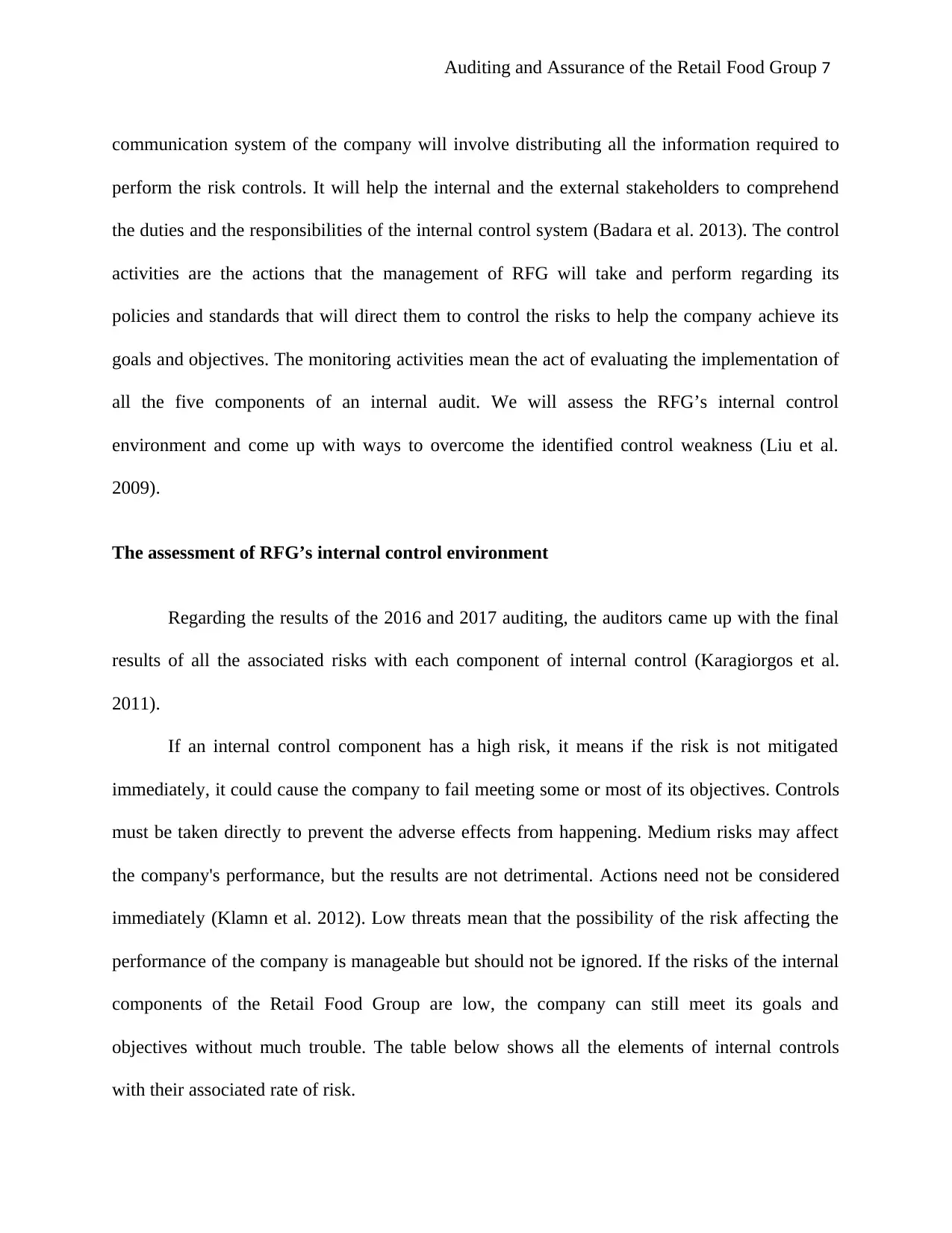
Auditing and Assurance of the Retail Food Group 7
communication system of the company will involve distributing all the information required to
perform the risk controls. It will help the internal and the external stakeholders to comprehend
the duties and the responsibilities of the internal control system (Badara et al. 2013). The control
activities are the actions that the management of RFG will take and perform regarding its
policies and standards that will direct them to control the risks to help the company achieve its
goals and objectives. The monitoring activities mean the act of evaluating the implementation of
all the five components of an internal audit. We will assess the RFG’s internal control
environment and come up with ways to overcome the identified control weakness (Liu et al.
2009).
The assessment of RFG’s internal control environment
Regarding the results of the 2016 and 2017 auditing, the auditors came up with the final
results of all the associated risks with each component of internal control (Karagiorgos et al.
2011).
If an internal control component has a high risk, it means if the risk is not mitigated
immediately, it could cause the company to fail meeting some or most of its objectives. Controls
must be taken directly to prevent the adverse effects from happening. Medium risks may affect
the company's performance, but the results are not detrimental. Actions need not be considered
immediately (Klamn et al. 2012). Low threats mean that the possibility of the risk affecting the
performance of the company is manageable but should not be ignored. If the risks of the internal
components of the Retail Food Group are low, the company can still meet its goals and
objectives without much trouble. The table below shows all the elements of internal controls
with their associated rate of risk.
communication system of the company will involve distributing all the information required to
perform the risk controls. It will help the internal and the external stakeholders to comprehend
the duties and the responsibilities of the internal control system (Badara et al. 2013). The control
activities are the actions that the management of RFG will take and perform regarding its
policies and standards that will direct them to control the risks to help the company achieve its
goals and objectives. The monitoring activities mean the act of evaluating the implementation of
all the five components of an internal audit. We will assess the RFG’s internal control
environment and come up with ways to overcome the identified control weakness (Liu et al.
2009).
The assessment of RFG’s internal control environment
Regarding the results of the 2016 and 2017 auditing, the auditors came up with the final
results of all the associated risks with each component of internal control (Karagiorgos et al.
2011).
If an internal control component has a high risk, it means if the risk is not mitigated
immediately, it could cause the company to fail meeting some or most of its objectives. Controls
must be taken directly to prevent the adverse effects from happening. Medium risks may affect
the company's performance, but the results are not detrimental. Actions need not be considered
immediately (Klamn et al. 2012). Low threats mean that the possibility of the risk affecting the
performance of the company is manageable but should not be ignored. If the risks of the internal
components of the Retail Food Group are low, the company can still meet its goals and
objectives without much trouble. The table below shows all the elements of internal controls
with their associated rate of risk.
Paraphrase This Document
Need a fresh take? Get an instant paraphrase of this document with our AI Paraphraser
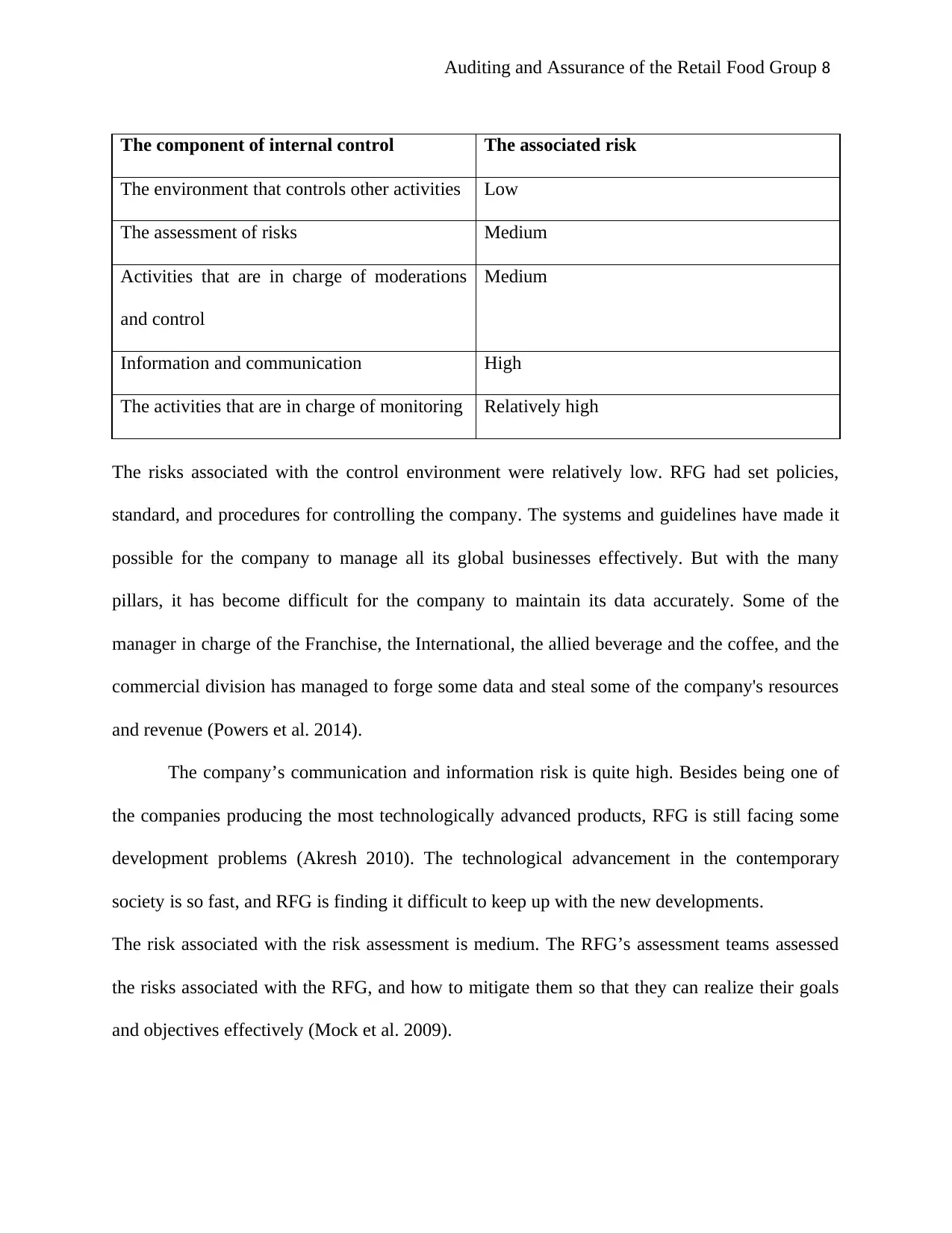
Auditing and Assurance of the Retail Food Group 8
The component of internal control The associated risk
The environment that controls other activities Low
The assessment of risks Medium
Activities that are in charge of moderations
and control
Medium
Information and communication High
The activities that are in charge of monitoring Relatively high
The risks associated with the control environment were relatively low. RFG had set policies,
standard, and procedures for controlling the company. The systems and guidelines have made it
possible for the company to manage all its global businesses effectively. But with the many
pillars, it has become difficult for the company to maintain its data accurately. Some of the
manager in charge of the Franchise, the International, the allied beverage and the coffee, and the
commercial division has managed to forge some data and steal some of the company's resources
and revenue (Powers et al. 2014).
The company’s communication and information risk is quite high. Besides being one of
the companies producing the most technologically advanced products, RFG is still facing some
development problems (Akresh 2010). The technological advancement in the contemporary
society is so fast, and RFG is finding it difficult to keep up with the new developments.
The risk associated with the risk assessment is medium. The RFG’s assessment teams assessed
the risks associated with the RFG, and how to mitigate them so that they can realize their goals
and objectives effectively (Mock et al. 2009).
The component of internal control The associated risk
The environment that controls other activities Low
The assessment of risks Medium
Activities that are in charge of moderations
and control
Medium
Information and communication High
The activities that are in charge of monitoring Relatively high
The risks associated with the control environment were relatively low. RFG had set policies,
standard, and procedures for controlling the company. The systems and guidelines have made it
possible for the company to manage all its global businesses effectively. But with the many
pillars, it has become difficult for the company to maintain its data accurately. Some of the
manager in charge of the Franchise, the International, the allied beverage and the coffee, and the
commercial division has managed to forge some data and steal some of the company's resources
and revenue (Powers et al. 2014).
The company’s communication and information risk is quite high. Besides being one of
the companies producing the most technologically advanced products, RFG is still facing some
development problems (Akresh 2010). The technological advancement in the contemporary
society is so fast, and RFG is finding it difficult to keep up with the new developments.
The risk associated with the risk assessment is medium. The RFG’s assessment teams assessed
the risks associated with the RFG, and how to mitigate them so that they can realize their goals
and objectives effectively (Mock et al. 2009).
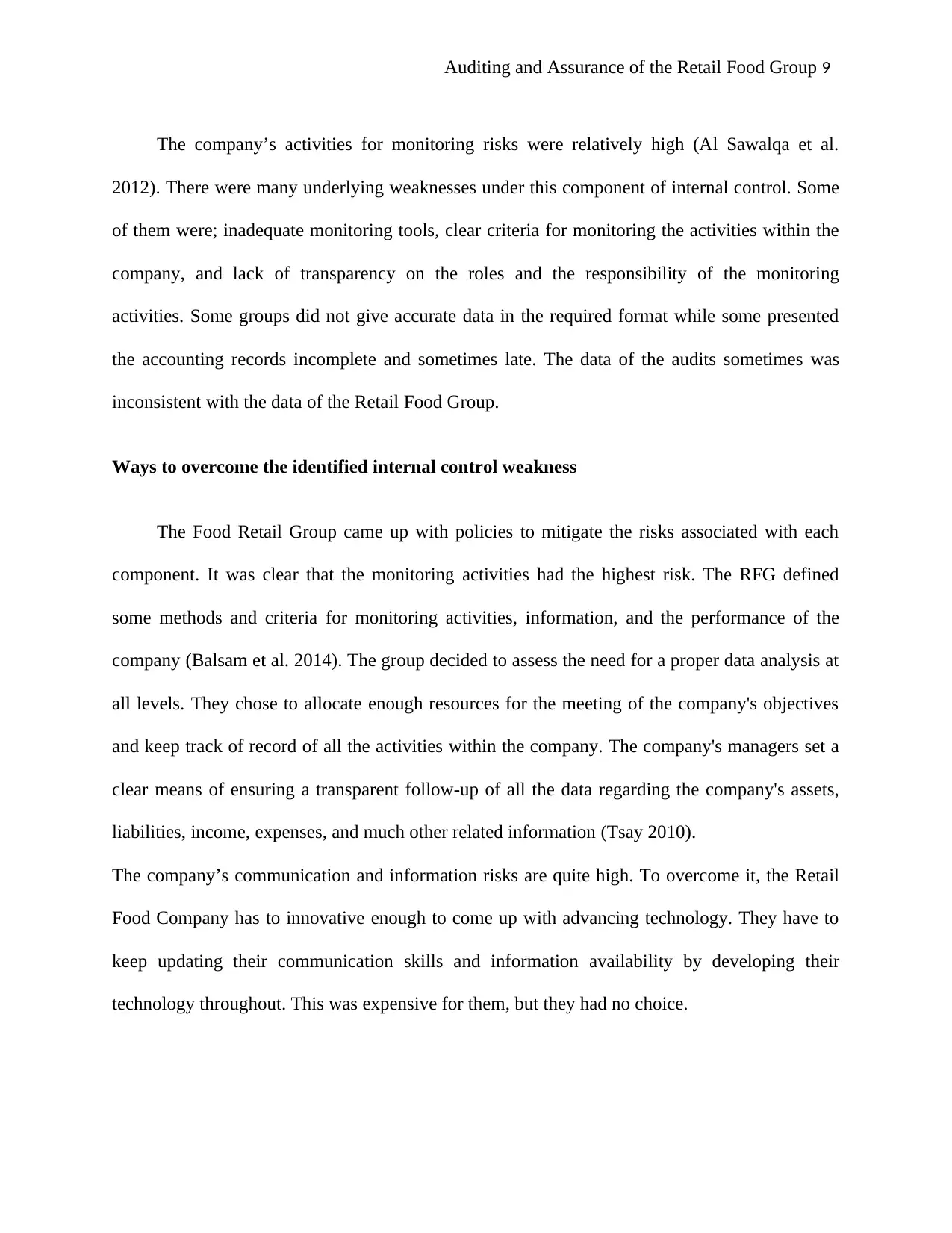
Auditing and Assurance of the Retail Food Group 9
The company’s activities for monitoring risks were relatively high (Al Sawalqa et al.
2012). There were many underlying weaknesses under this component of internal control. Some
of them were; inadequate monitoring tools, clear criteria for monitoring the activities within the
company, and lack of transparency on the roles and the responsibility of the monitoring
activities. Some groups did not give accurate data in the required format while some presented
the accounting records incomplete and sometimes late. The data of the audits sometimes was
inconsistent with the data of the Retail Food Group.
Ways to overcome the identified internal control weakness
The Food Retail Group came up with policies to mitigate the risks associated with each
component. It was clear that the monitoring activities had the highest risk. The RFG defined
some methods and criteria for monitoring activities, information, and the performance of the
company (Balsam et al. 2014). The group decided to assess the need for a proper data analysis at
all levels. They chose to allocate enough resources for the meeting of the company's objectives
and keep track of record of all the activities within the company. The company's managers set a
clear means of ensuring a transparent follow-up of all the data regarding the company's assets,
liabilities, income, expenses, and much other related information (Tsay 2010).
The company’s communication and information risks are quite high. To overcome it, the Retail
Food Company has to innovative enough to come up with advancing technology. They have to
keep updating their communication skills and information availability by developing their
technology throughout. This was expensive for them, but they had no choice.
The company’s activities for monitoring risks were relatively high (Al Sawalqa et al.
2012). There were many underlying weaknesses under this component of internal control. Some
of them were; inadequate monitoring tools, clear criteria for monitoring the activities within the
company, and lack of transparency on the roles and the responsibility of the monitoring
activities. Some groups did not give accurate data in the required format while some presented
the accounting records incomplete and sometimes late. The data of the audits sometimes was
inconsistent with the data of the Retail Food Group.
Ways to overcome the identified internal control weakness
The Food Retail Group came up with policies to mitigate the risks associated with each
component. It was clear that the monitoring activities had the highest risk. The RFG defined
some methods and criteria for monitoring activities, information, and the performance of the
company (Balsam et al. 2014). The group decided to assess the need for a proper data analysis at
all levels. They chose to allocate enough resources for the meeting of the company's objectives
and keep track of record of all the activities within the company. The company's managers set a
clear means of ensuring a transparent follow-up of all the data regarding the company's assets,
liabilities, income, expenses, and much other related information (Tsay 2010).
The company’s communication and information risks are quite high. To overcome it, the Retail
Food Company has to innovative enough to come up with advancing technology. They have to
keep updating their communication skills and information availability by developing their
technology throughout. This was expensive for them, but they had no choice.
⊘ This is a preview!⊘
Do you want full access?
Subscribe today to unlock all pages.

Trusted by 1+ million students worldwide

Auditing and Assurance of the Retail Food Group 10
The business risk associated with the RFG from the auditors’ point of view
The Franchise is the RFG's most significant source of income. The auditor's reports
showed that they contribute over 40% of the company's total EBITDA and sequentially they are
RFG's most significant source of income. The company is over pressuring them thus making the
RTG's revenue unsustainable. Over 10% of the Franchise market is weak, and this is a signal of
problems. The company is increasing the EPS (Earnings Per Share) and the dividends they are
giving to their shareholders. They raised the shareholder's EPS from 40.5cps in 2016 to 43.7cps
in 2017, as per their accounting records. This was a 7.9% rise in the EPS. They also increased
their dividends from 27.5cps to 29.75cps. Expanding the shareholder's cent per share could be an
advantage by earning the company more shareholders, but on the other hand, it could reduce
their revenue over time if they raise them without considering cost factors.
Due to its large size, the company is highly sensitive to its markets shocks. Many investors
would opt to go for smaller companies in the hospitality industry as a result. The cost of
maintaining such a big company is also high, and slight poor management would mean a
deterioration in the company’s revenue and income. It could also mean a failure of the company,
and its operations might cease (Rossier et al. 2015).
The risks the company has regarding protecting its assets are very high. Insurance companies
demand high insurance fees to insure them. The costs of maintaining their business assets, other
than insurance are also very high. Such costs include repair and renewal of these assets, the costs
of securing them, and many other related costs.
The company has high revenues and income from their various operations. These high revenues
attract incredibly high taxation from the government. It is usually a huge challenge for the Retail
The business risk associated with the RFG from the auditors’ point of view
The Franchise is the RFG's most significant source of income. The auditor's reports
showed that they contribute over 40% of the company's total EBITDA and sequentially they are
RFG's most significant source of income. The company is over pressuring them thus making the
RTG's revenue unsustainable. Over 10% of the Franchise market is weak, and this is a signal of
problems. The company is increasing the EPS (Earnings Per Share) and the dividends they are
giving to their shareholders. They raised the shareholder's EPS from 40.5cps in 2016 to 43.7cps
in 2017, as per their accounting records. This was a 7.9% rise in the EPS. They also increased
their dividends from 27.5cps to 29.75cps. Expanding the shareholder's cent per share could be an
advantage by earning the company more shareholders, but on the other hand, it could reduce
their revenue over time if they raise them without considering cost factors.
Due to its large size, the company is highly sensitive to its markets shocks. Many investors
would opt to go for smaller companies in the hospitality industry as a result. The cost of
maintaining such a big company is also high, and slight poor management would mean a
deterioration in the company’s revenue and income. It could also mean a failure of the company,
and its operations might cease (Rossier et al. 2015).
The risks the company has regarding protecting its assets are very high. Insurance companies
demand high insurance fees to insure them. The costs of maintaining their business assets, other
than insurance are also very high. Such costs include repair and renewal of these assets, the costs
of securing them, and many other related costs.
The company has high revenues and income from their various operations. These high revenues
attract incredibly high taxation from the government. It is usually a huge challenge for the Retail
Paraphrase This Document
Need a fresh take? Get an instant paraphrase of this document with our AI Paraphraser
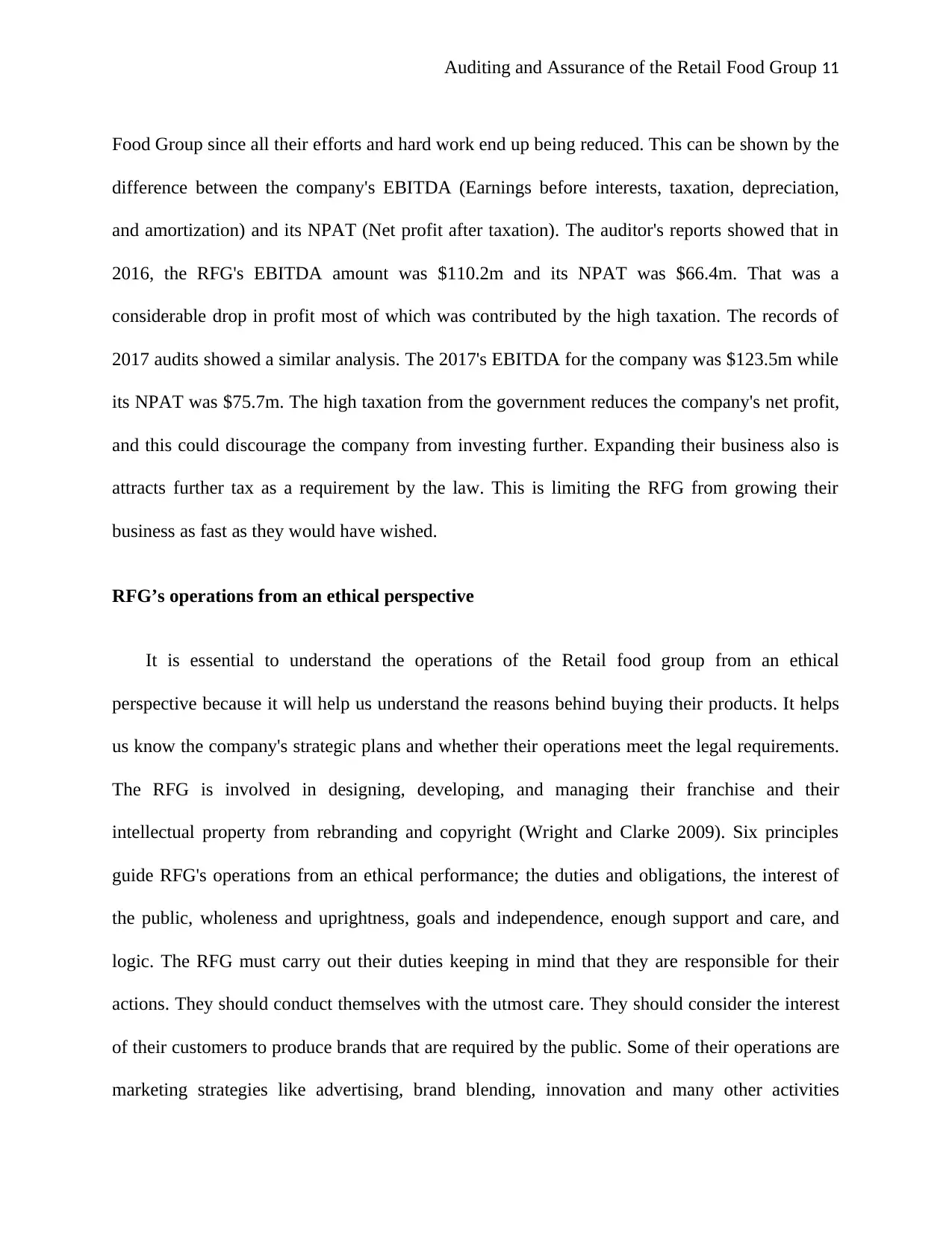
Auditing and Assurance of the Retail Food Group 11
Food Group since all their efforts and hard work end up being reduced. This can be shown by the
difference between the company's EBITDA (Earnings before interests, taxation, depreciation,
and amortization) and its NPAT (Net profit after taxation). The auditor's reports showed that in
2016, the RFG's EBITDA amount was $110.2m and its NPAT was $66.4m. That was a
considerable drop in profit most of which was contributed by the high taxation. The records of
2017 audits showed a similar analysis. The 2017's EBITDA for the company was $123.5m while
its NPAT was $75.7m. The high taxation from the government reduces the company's net profit,
and this could discourage the company from investing further. Expanding their business also is
attracts further tax as a requirement by the law. This is limiting the RFG from growing their
business as fast as they would have wished.
RFG’s operations from an ethical perspective
It is essential to understand the operations of the Retail food group from an ethical
perspective because it will help us understand the reasons behind buying their products. It helps
us know the company's strategic plans and whether their operations meet the legal requirements.
The RFG is involved in designing, developing, and managing their franchise and their
intellectual property from rebranding and copyright (Wright and Clarke 2009). Six principles
guide RFG's operations from an ethical performance; the duties and obligations, the interest of
the public, wholeness and uprightness, goals and independence, enough support and care, and
logic. The RFG must carry out their duties keeping in mind that they are responsible for their
actions. They should conduct themselves with the utmost care. They should consider the interest
of their customers to produce brands that are required by the public. Some of their operations are
marketing strategies like advertising, brand blending, innovation and many other activities
Food Group since all their efforts and hard work end up being reduced. This can be shown by the
difference between the company's EBITDA (Earnings before interests, taxation, depreciation,
and amortization) and its NPAT (Net profit after taxation). The auditor's reports showed that in
2016, the RFG's EBITDA amount was $110.2m and its NPAT was $66.4m. That was a
considerable drop in profit most of which was contributed by the high taxation. The records of
2017 audits showed a similar analysis. The 2017's EBITDA for the company was $123.5m while
its NPAT was $75.7m. The high taxation from the government reduces the company's net profit,
and this could discourage the company from investing further. Expanding their business also is
attracts further tax as a requirement by the law. This is limiting the RFG from growing their
business as fast as they would have wished.
RFG’s operations from an ethical perspective
It is essential to understand the operations of the Retail food group from an ethical
perspective because it will help us understand the reasons behind buying their products. It helps
us know the company's strategic plans and whether their operations meet the legal requirements.
The RFG is involved in designing, developing, and managing their franchise and their
intellectual property from rebranding and copyright (Wright and Clarke 2009). Six principles
guide RFG's operations from an ethical performance; the duties and obligations, the interest of
the public, wholeness and uprightness, goals and independence, enough support and care, and
logic. The RFG must carry out their duties keeping in mind that they are responsible for their
actions. They should conduct themselves with the utmost care. They should consider the interest
of their customers to produce brands that are required by the public. Some of their operations are
marketing strategies like advertising, brand blending, innovation and many other activities

Auditing and Assurance of the Retail Food Group 12
(Leschewski 2016). The RFG has franchised their products, made various types of brands, and
promoted retailing of their products (Wright and Clarke 2009). All these operations should be
carried out ethically while following six principles.
The deficiencies in the practice of RFG’s operations
The Retail Food Group's product is not very popular compared to that of their competitors.
This is because they have poor marketing strategies which have affected the awareness of their
brands in the market (Hattersley 2013). There is a quite big contrast between the perception of
RFG's brands and that of their competitors' brands. The RFG aims at improving their market
strategies and making their products known to their customers. To be able to accomplish this
new objective, they will develop market franchises to improve their advertising and marketing
strategies (Ashbaugh‐Skaife et al. 2009). An increase in the use of mobile phones will force the
RFG to be more innovative to increase the chances of their products being bought online. If they
don't consider this new development, the demand for their products will remain stagnant, and
thus their competitors will have an advantage over them (Jiang et al. 2010). This innovation will
cause them a lot of money, and then it will take time before they recover all those resources. The
RFG has high debts since its debt to equity ratio is 69.95%. This means that the company is
currently making losses and its current assets might not be able to pay for all its liabilities.
Why ethical issues should interest the auditors
Auditors must promote ethical conduct while doing their professional responsibilities and
duties (Wright and Clarke 2009). It is a legal requirement of the law that all the auditors ethically
conduct themselves by giving the correct audit records. The ethical issues such as the marketing
(Leschewski 2016). The RFG has franchised their products, made various types of brands, and
promoted retailing of their products (Wright and Clarke 2009). All these operations should be
carried out ethically while following six principles.
The deficiencies in the practice of RFG’s operations
The Retail Food Group's product is not very popular compared to that of their competitors.
This is because they have poor marketing strategies which have affected the awareness of their
brands in the market (Hattersley 2013). There is a quite big contrast between the perception of
RFG's brands and that of their competitors' brands. The RFG aims at improving their market
strategies and making their products known to their customers. To be able to accomplish this
new objective, they will develop market franchises to improve their advertising and marketing
strategies (Ashbaugh‐Skaife et al. 2009). An increase in the use of mobile phones will force the
RFG to be more innovative to increase the chances of their products being bought online. If they
don't consider this new development, the demand for their products will remain stagnant, and
thus their competitors will have an advantage over them (Jiang et al. 2010). This innovation will
cause them a lot of money, and then it will take time before they recover all those resources. The
RFG has high debts since its debt to equity ratio is 69.95%. This means that the company is
currently making losses and its current assets might not be able to pay for all its liabilities.
Why ethical issues should interest the auditors
Auditors must promote ethical conduct while doing their professional responsibilities and
duties (Wright and Clarke 2009). It is a legal requirement of the law that all the auditors ethically
conduct themselves by giving the correct audit records. The ethical issues such as the marketing
⊘ This is a preview!⊘
Do you want full access?
Subscribe today to unlock all pages.

Trusted by 1+ million students worldwide
1 out of 17
Related Documents
Your All-in-One AI-Powered Toolkit for Academic Success.
+13062052269
info@desklib.com
Available 24*7 on WhatsApp / Email
![[object Object]](/_next/static/media/star-bottom.7253800d.svg)
Unlock your academic potential
Copyright © 2020–2025 A2Z Services. All Rights Reserved. Developed and managed by ZUCOL.





